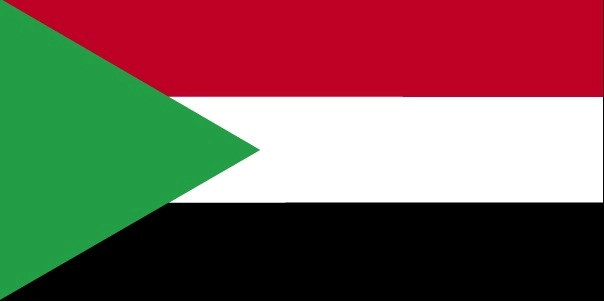
Sudan
Country Flag Details
three equal horizontal bands of black (top), red, and green; the red band is edged in white; a blue isosceles triangle based on the hoist side contains a gold, five-pointed star; black represents the people of South Sudan, red the blood shed in the struggle for freedom, green the verdant land, and blue the waters of the Nile; the gold star represents the unity of the states making up South Sudan
note: resembles the flag of Kenya; one of only two national flags to display six colors as part of its primary design, the other is South Africa’s.
Background
South Sudan, which gained independence from Sudan in 2011, is the world’s newest country. When Sudan attained independence in 1956, the southerners were assured of full participation in the political system, but the Arab government in Khartoum reneged on its promises. Since independence, South Sudan has struggled to form a viable governing system and has been plagued by widespread corruption, political conflict, and communal violence. Implementation of a 2018 peace agreement has been stalled as South Sudanese leaders wrangle over power-sharing.
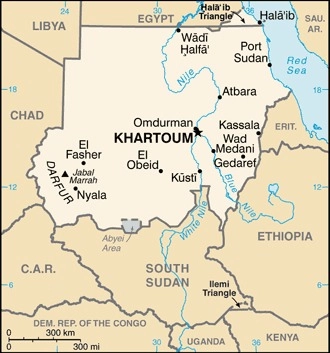
Geography
Area
total : 644,329 sq km
Climate
hot with seasonal rainfall influenced by the annual shift of the Inter-Tropical Convergence Zone; rainfall heaviest in upland areas of the south and diminishes to the north
Natural resources
hydropower, fertile agricultural land, gold, diamonds, petroleum, hardwoods, limestone, iron ore, copper, chromium ore, zinc, tungsten, mica, silver
People and Society
Population
total: 12,703,714
Ethnic groups
Dinka (Jieng) approximately 35-40%, Nuer (Naath) approximately 15%, Shilluk (Chollo), Azande, Bari, Kakwa, Kuku, Murle, Mandari, Didinga, Ndogo, Bviri, Lndi, Anuak, Bongo, Lango, Dungotona, Acholi, Baka, Fertit (2011 est.)
Languages
English (official), Arabic (includes Juba and Sudanese variants), ethnic languages include Dinka, Nuer, Bari, Zande, Shilluk
Religions
Christian 60.5%, folk religion 32.9%, Muslim 6.2%, other <1%, unaffiliated <1% (2020 est.)
Population growth rate
4.65% (2024 est.)
Government
Government type
presidential republic
Capital name: Juba
Executive branch
chief of state: President Salva KIIR Mayardit (since 9 July 2011)
head of government: President Salva KIIR Mayardit (since 9 July 2011)
Economy
Economic overview
low-income, oil-based Sahelian economy; extreme poverty and food insecurity; COVID-19 and ongoing violence threaten socioeconomic potential; environmentally fragile; ongoing land and property rights issues; natural resource rich but lacks infrastructure
Real GDP (purchasing power parity)
$20.01 billion (2017 est.)
$21.1 billion (2016 est.)
$24.52 billion (2015 est.)
Real GDP per capita
$1,600 (2017 est.)
$1,700 (2016 est.)
$2,100 (2015 est.)
Exports
$4.499 billion (2023 est.)
$5.811 billion (2022 est.)
$4.652 billion (2021 est.)
Exports – partners
China 51%, Singapore 29%, UAE 10%, Germany 4%, Uganda 3% (2023)
Exports – commodities
crude petroleum, refined petroleum, forage crops, gold, scrap iron (2023)
Imports
$4.443 billion (2023 est.)
$6.402 billion (2022 est.)
$4.037 billion (2021 est.)
Imports – partners
Uganda 33%, UAE 26%, Kenya 14%, China 10%, USA 3% (2023)
Imports – commodities
garments, cement, other foods, iron bars, cereal flours (2023)

Export structure by product group in 2023 (% of total exports) (UNCTAD)
The export structure of a nation serves as a vital indicator of the diversity, composition, and value of its internationally traded goods and services, offering crucial insights into the economic health, competitiveness, and developmental status of the country. In the case of Sudan, the current export structure heavily depends on the extraction of natural resources and the production of agricultural products, which poses risks to long-term sustainability. Therefore, it becomes essential to pursue strategies for diversifying the export portfolio to include a wider array of goods and services, while also addressing significant challenges such as smuggling activities and disruptions arising from ongoing conflicts. These efforts are not merely beneficial; they are critical for promoting greater economic stability, enhancing resilience, and fostering sustainable growth that can uplift the nation as a whole.
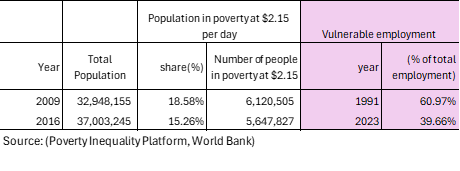
Understanding poverty level significance at $2.15 per day
In 2023, 40 percent of Sudan’s total employment was classified as vulnerable employment, a term that denotes work marked by insufficient job security, low remuneration, and a notable absence of social protections, including health insurance, pension plans, or labor rights. This category encompasses own-account workers, who are individuals engaged in self-employment without any employees, such as street vendors and small-scale farmers, as well as contributing family workers, who assist in family-owned enterprises or agricultural operations without receiving formal compensation. Employment in these roles is frequently informal and unstable, devoid of benefits, which renders workers particularly vulnerable to economic shocks, exploitation, and chronic poverty. The ramifications of such employment extend beyond the individual, affecting families and communities at large and perpetuating cycles of instability and hardship that are difficult to overcome.
Understanding poverty level significance at $2.15 per day
In 2016, 15 percent of Sudan’s population (about 6 million people) lived in poverty at $2.15 per day. The poverty level at $2.15 per day (measured in 2017 purchasing power parity, or PPP) is a key global benchmark used by the World Bank to define extreme poverty in low-income countries. It indicates:
1. Basic Survival Threshold
• People living below $2.15 per day struggle to afford essential needs such as food, clean water, shelter, healthcare, and education.
2. Economic Underdevelopment
• A high percentage of a country’s population living below this threshold suggests low economic productivity, high unemployment, and weak social safety nets.
3. Inequality and Social Vulnerability
• It reflects deep income inequality and a lack of access to opportunities for upward mobility.
• People in this category are more vulnerable to shocks like food price increases, climate disasters, or health crises.
4. Policy Challenges
• Governments need targeted interventions such as social welfare programs, job creation, and improved access to education and healthcare to reduce poverty.
A country's export structure is a reflection of its level of development and productive capacities
The export structure of a country refers to the composition, diversity, and value of the goods and services it sells to other countries. It provides key insights into the country’s economic health, competitiveness, and level of development. Productive capacities of a country refer to its ability to produce goods and services efficiently and sustainably over time. These capacities are shaped by various factors, including human capital, natural resources, infrastructure, private sector, development, technology & innovation, institutions & governance, financial systems trade & market access.
Here’s what the export structure and productive capacities of a country typically indicate:
- Level of Economic Development
- Developed economies usually export high-value manufactured goods, technology, and services.
- Developing economies often rely on raw materials, agricultural products, or low-value manufactured goods.
- Industrial and Sectoral Strengths
- A strong presence of high-tech or industrial goods (e.g., machinery, electronics) suggests a well-developed manufacturing sector.
- A dominance of commodities (e.g., oil, minerals, agricultural products) indicates reliance on natural resources.
- Export Diversification
- A diverse export base (multiple industries) makes a country’s economy more stable and resilient to global price shocks.
- A concentrated export base (few key products) makes it vulnerable to market fluctuations.
- Trade Partnerships and Dependence
- If exports are heavily dependent on a single country or region, the economy is more exposed to geopolitical and trade risks.
- A wide range of trading partners indicates stronger global integration.
- Competitiveness and Value Addition
- Exporting mainly raw materials (e.g., crude oil instead of refined petroleum) suggests limited industrial processing capacity.
- A high share of finished and high-tech goods suggests strong value addition and competitiveness.
Sudan -Sanitation
Sudan – Proportion of population served with at least basic sanitation
In 2022, the proportion of the population served with at least basic sanitation in Sudan was 38%. The proportion of the population served with at least basic sanitation in Sudan increased from 20.6% in 2000 to 38% in 2022, an absolute change of 17.4 percentage points (pp) between 2000 and 2022.
Sudan – Proportion of urban population served with at least basic sanitation
In 2020, the proportion of the urban population served with at least basic sanitation in Sudan was 60.1 %. The proportion of the urban population served with at least basic sanitation in Sudan increased from 40.5 % in 2000 to 60.1 % in 2020, an absolute change of 19.6 pp between 2000 and 2022.
Sudan – Proportion of rural population served with at least basic sanitation
In 2022, the proportion of the rural population served with at least basic sanitation in Sudan was 26.0 %. The proportion of the rural population served with at least basic sanitation in Sudan increased from 11.0 % in 2000 to 26.0% in 2022, an absolute change of 15 percentage points (pp) between 2000 and 2022.
Sudan – Proportion of population served with at least basic sanitation: A Global Perspective
The persistent lack of safe sanitation is a grave issue that requires urgent and collective action to prevent the tragic loss of countless lives each year, highlighting a significant public health crisis that demands our attention. Safe sanitation is not just a necessity; it is a fundamental human right that must be ensured for everyone. In 2022, nearly 30 million people, or about 63 percent of Sudan’s population, faced the severe consequences of inadequate sanitation facilities, starkly contrasting with countries like Vietnam, China, and Thailand where only 8 percent, 5 percent, and 1 percent lacked these essential services, respectively. With a global average of around 6 percent, it is clear that collaborative efforts are urgently needed to improve sanitation access in underserved regions of Sub-Saharan Africa, where the impacts can profoundly affect health, dignity, and quality of life, necessitating a united response from the global community.

Sudan – Proportion of rural population served with at least basic sanitation: A Global Perspective
In 2022, nearly 23 million people in rural Sudan, representing about 76 percent of the population, lacked even basic sanitation facilities, a troubling contrast to Vietnam, Sri Lanka, and Thailand, where access rates were significantly higher at 12 percent, 5 percent, and 2 percent respectively. This critical shortage of safe sanitation is a pressing public health crisis that demands immediate action, leading to countless preventable deaths each year. Access to sanitation is not just a necessity; it is a fundamental human right that every individual deserves. We must come together in advocacy for this essential right across Sub-Saharan Africa, where the need for change is urgent and the potential for meaningful community transformation is vital for the dignity and well-being of all.
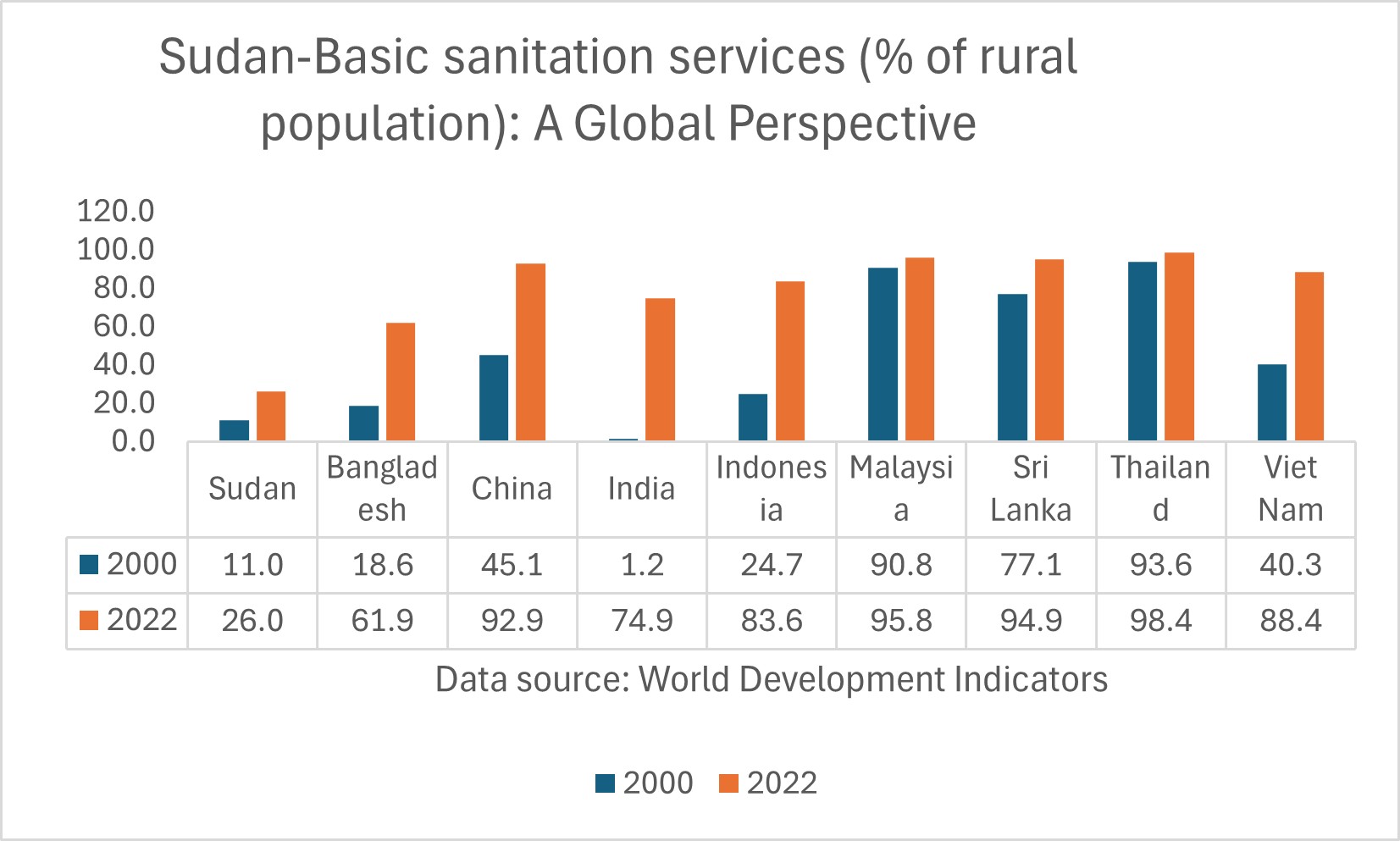
Sudan-Water Supply
Sudan- Proportion of total population served with at least basic water
In 2022, the proportion of the population served with at least basic water in Sudan was 64.9 %. The proportion of the population served with at least basic water in Sudan increased from 44.6 % in 2000 to 64.9 % in 2022, an absolute change of 20.3 pp between 2000 and 2022.
Sudan – Proportion of urban population served with at least basic water
In 2022, the proportion of the urban population served with at least basic water in Sudan was 74.2 %. The proportion of the urban population served with at least basic water of Sudan increased from 62.5 % in 2000 to 74.2 % in 2022, an absolute increase of 11.7 pp between 2000 and 2022.
Sudan – Proportion of rural population with at least basic water
In 2022, the proportion of the rural population served with at least basic water in Sudan was 59.7 %. Proportion of rural population served with at least basic water in Sudan increased from 36.1 % in 2000 to 59.7 % in 2022, an absolute increase of 23.6 pp between 2000 and 2022.
Sudan- Proportion of population served with at least basic drinking water: A Global Perspective
Access to safe drinking water is essential for survival and a fundamental human right that demands urgent collective action. In 2022, nearly 12 million people in Sudan, about 25 percent of the population, were without this vital resource, highlighting a serious public health crisis. In contrast, everyone in Thailand and 98 percent of people in Vietnam and Bangladesh had reliable access to safe drinking water that same year. This disparity calls for transformative changes in Sub-Saharan Africa, where many still lack basic resources to improve their quality of life. We must unite to close this gap and ensure that everyone can access the safe drinking water they deserve, reflecting our shared moral obligation as a global community.
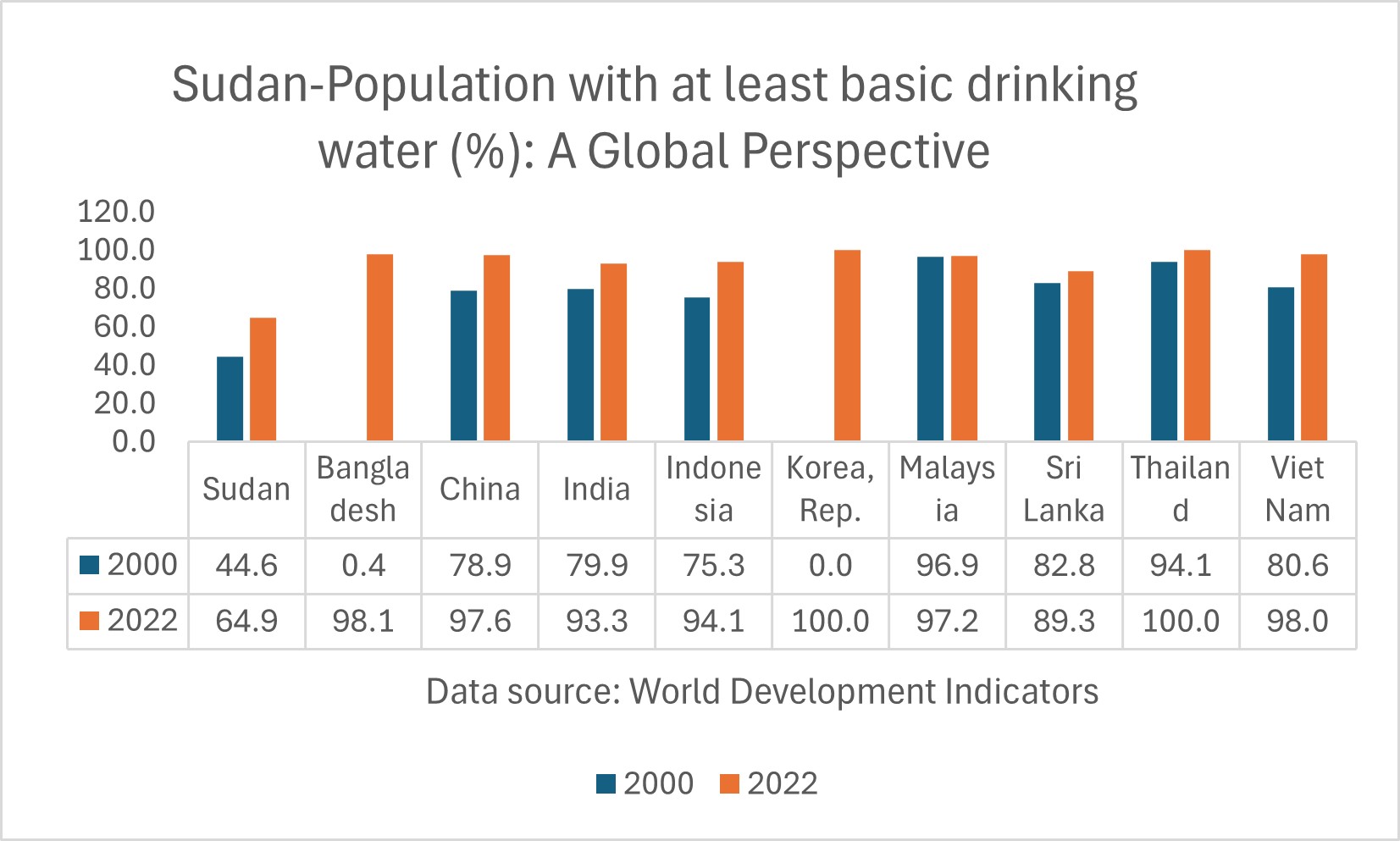
Sudan- Proportion of rural population served with at least basic drinking water: A Global Perspective
Sudan faces a critical crisis, with nearly 40 percent of its rural population, or about 12 million people, lacking access to safe drinking water in 2022. This situation highlights a severe humanitarian emergency that requires urgent action from the international community. In contrast, countries like Thailand, and Vietnam have achieved near-universal access to safe drinking water, with availability rates of 100 percent, and 97 percent, respectively. This stark disparity underscores the governance challenges within many Sub-Saharan African nations and emphasizes the pressing need for collaborative initiatives to enhance living conditions and ensure access to essential resources for the most vulnerable communities across Sub-Saharan Africa.
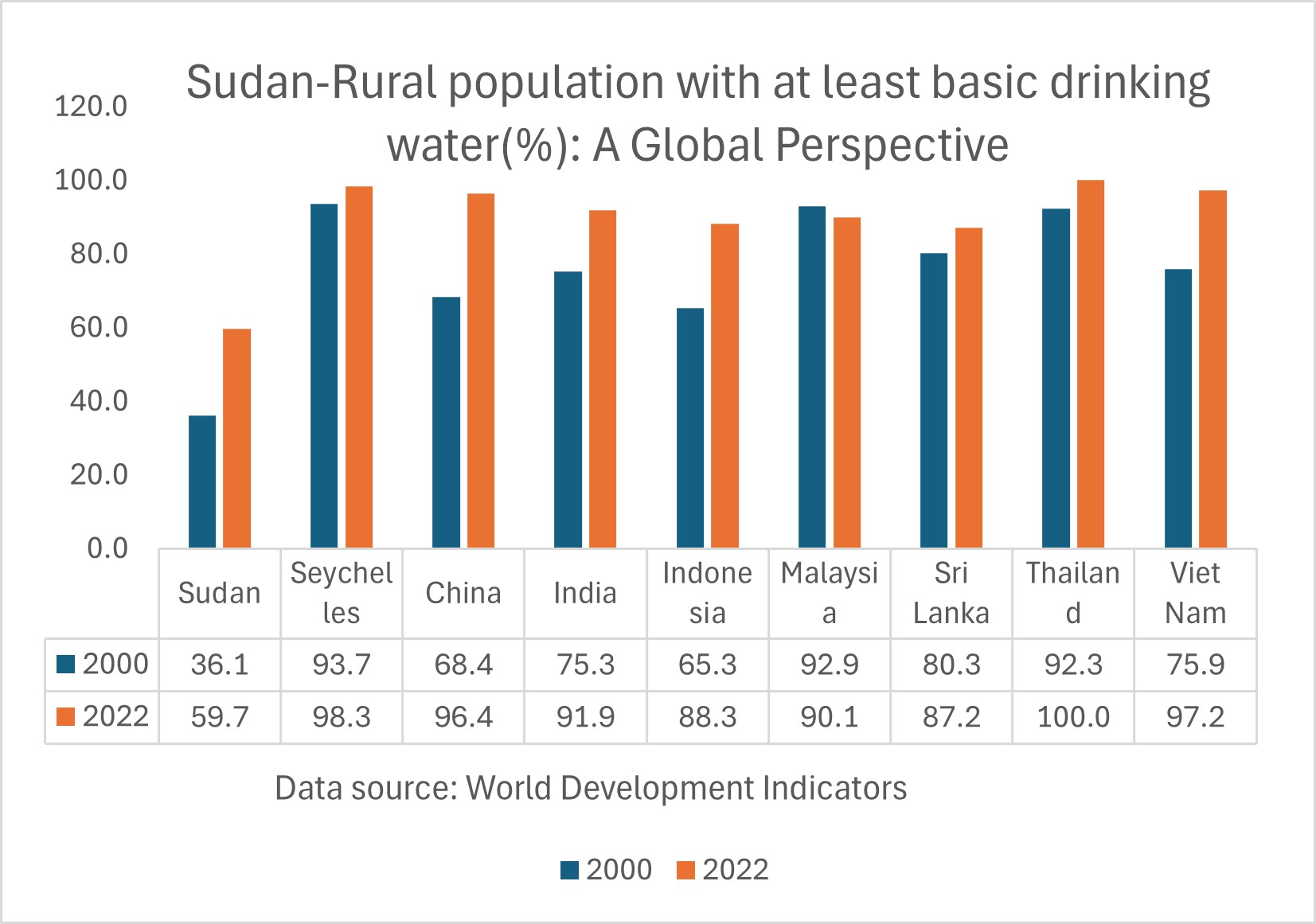
Sudan-Access to Electricity
Sudan- Access to electricity (% of population)
In 2022, proportion of population with access to electricity for Sudan was 63.2 % in 2022. The proportion of population with access to electricity of Sudan increased from 26.9% in 2000 to 63.2% in 2022, an absolute change of 40.2pp between 2000 and 2022.
Sudan- Access to electricity (% urban population)
In 2022, the proportion of the urban population with access to electricity in Sunday was 84%. The proportion of urban population with access to electricity of Sudan increased from 61.6% % in 2000 to 84% in 2022, an absolute change of 22.4 pp between 2000 and 2022.
Sudan- Access to electricity (% of rural population)
In 2022, proportion of rural population with access to electricity for Sudan was 49.4 %. The proportion of rural population with access to electricity of Sudan increased from 4.4 % in 2000 to 49.4% in 2022, an absolute change of 45 pp between and 2022.
Sudan – Proportion of population served with electricity: A Global Perspective
In 2022 nearly 37 percent of the population in Burundi lacked access to electricity, a critical crisis impacting over 18 million people who depend on this essential service for survival. This situation is starkly contrasted by countries like Vietnam, Thailand, Sri Lanka, and Malaysia, which have achieved universal electricity access, highlighting the urgent need for systemic reforms in Sub-Saharan Africa to improve living conditions. The absence of reliable electricity not only hampers development but also undermines health, education, and economic opportunities, making it essential for the people of Burundi to envision a more sustainable future. Immediate action is crucial to close this electricity gap, ensuring that everyone has access to the power needed for a better life and the potential for growth and prosperity.
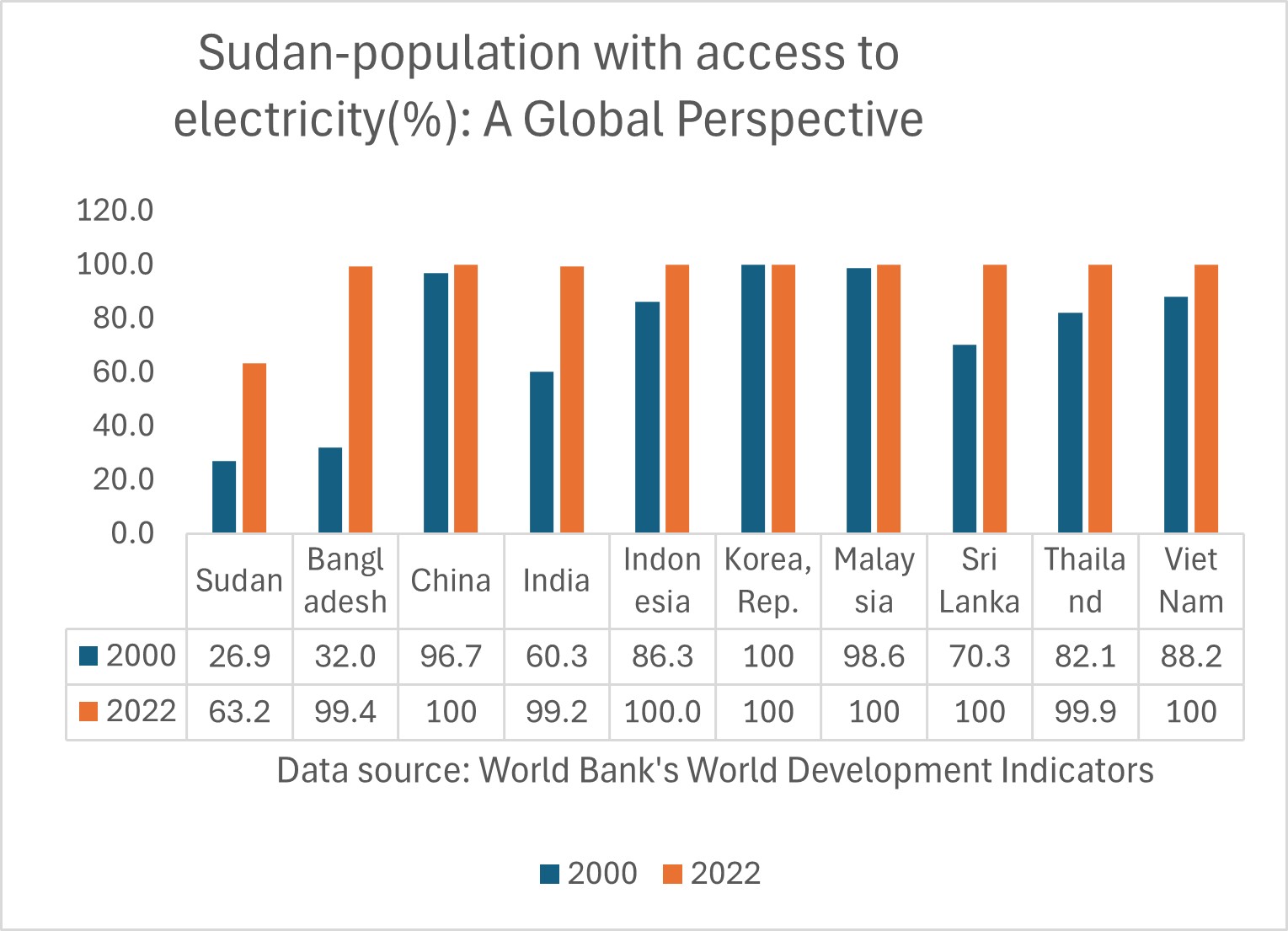
Sudan – Proportion of rural population served with electricity: A Global Perspective
In 2022, an alarming 51 percent of Sudan’s rural population, nearly 16 million people, lived without electricity, a stark contrast to countries like Vietnam, Thailand, and Sri Lanka, where all rural residents have access to this essential resource. Likewise, India and Bangladesh achieve 99 percent access for their rural populations. These figures highlight the urgent need for transformative governance reforms across Sub-Saharan Africa. We must advocate for initiatives that provide reliable electricity access, empowering communities to thrive and work towards a sustainable, equitable, and prosperous future for all.

Sudan: Health outcomes
Sudan-Life expectancy: A Global Perspective
As we examine life expectancy trends over the past seven decades, it is evident that while advancements have led to longer and healthier lives for many, significant disparities endure, particularly in Sub-Saharan Africa. The global average life expectancy for newborns has risen from 47 years in 1950 to 71 years by 2021, yet progress in Sub-Saharan African nations remains limited. For example, Sudan’s life expectancy grew from 47 years in 1960 to 66 years in 2022, underscoring ongoing challenges. In contrast, South Korea’s life expectancy increased from 54 years in 1960 to 83 years in 2022, while the Maldives improved from 39 years in 1960 to 81 years in 2022. The low life expectancy in several Sub-Saharan countries reflects complex issues such as chronic poverty and inadequate healthcare. This scenario highlights the urgent need for transformative efforts to ensure that global progress reaches all communities, leaving no one behind in the pursuit of health and well-being.
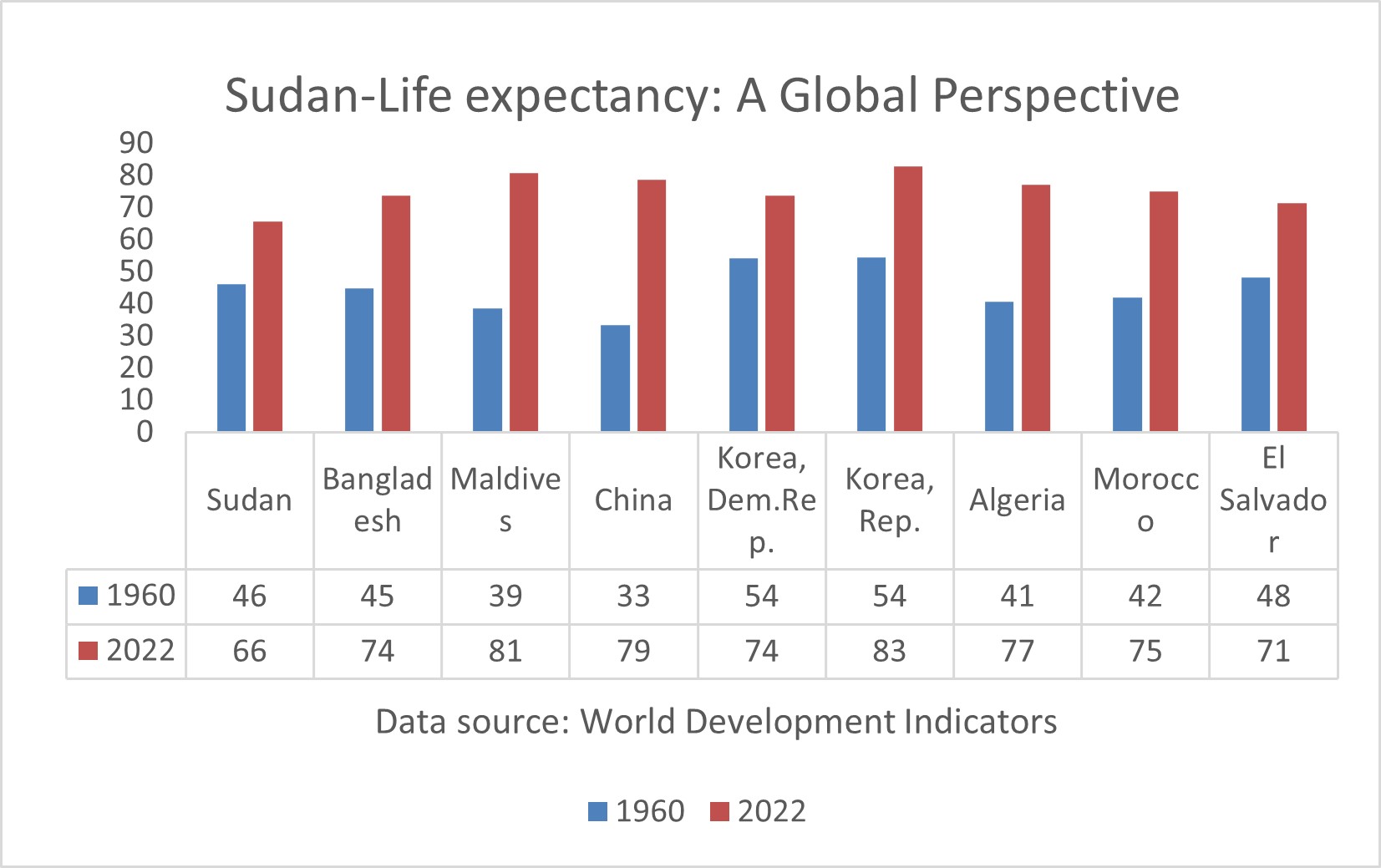
Sudan-Mortality rate, under-5 (per 1,000 live births): A Global Perspective
Since 1950, there has been a significant global decline in child mortality rates, largely due to better living standards, healthcare access, improved nutrition, and safe drinking water. Developed nations in Europe and America have seen rates drop to under 4 percent, reflecting strong healthcare systems and socioeconomic stability. Many developing countries in South America, Asia, and Africa have made progress over the past seventy years, though advancements in Sub-Saharan Africa have been slow and inconsistent. For example, Sudan’s under-five mortality rate fell from 147 in 1980 to 52 in 2022, while Bangladesh achieved a notable drop from 206 to 29 in the same period, with India closely following suit from 169 to 29. These statistics underscore the ongoing challenges of inadequate healthcare systems and highlight the urgent need for governance reforms in Sub-Saharan Africa to effectively reduce child mortality and improve health outcomes for vulnerable populations, emphasizing the importance of international collaboration and investment in sustainable health initiatives.

Sudan-Maternal mortality ratio (per 100,000 live births): A Global Perspective
Sudan’s maternal mortality ratio has notably declined from 642 in 2000 to 270 in 2020, reflecting significant progress; however, it highlights the ongoing challenges mothers face nationwide. This improvement contrasts sharply with lower ratios in Bangladesh, India, and Vietnam, which reported figures of 123, 103, and 46 in 2022, respectively. These statistics call for urgent action as pregnancy-related fatalities remain a critical issue in Sudan, exacerbated by high birth rates and persistent maternal health challenges. The troubling data emphasizes serious shortcomings within the healthcare system and chronic underfunding in many Sub-Saharan African nations. The disparities in maternal health outcomes compared to other developing regions necessitate a call to action for substantial investments in health infrastructure, focusing on the health and well-being of mothers and their children in Sudan.
